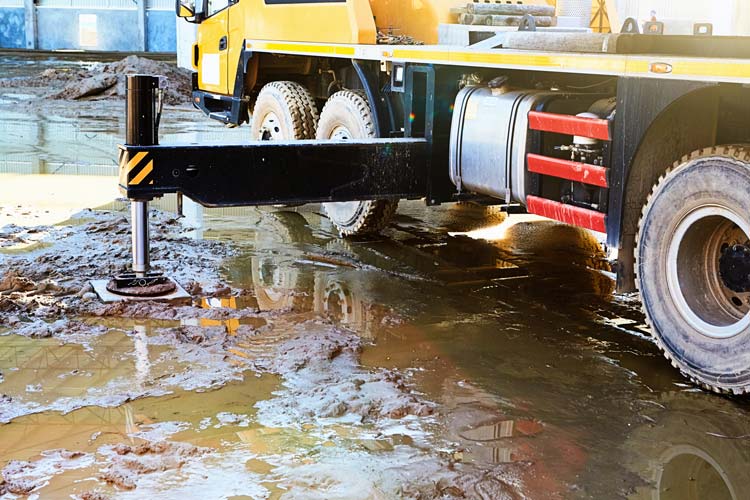Blog
Mitigating or Preventing Water Damage
Water's capacity to inflict severe and costly damage looms large over all construction projects. Whether it's caused by Mother Nature or human error, water damage presents a ubiquitous threat. Because construction water damage claims can climb to hundreds of thousands of dollars, it's worth taking steps to mitigate or prevent incidents, if possible. The cause of water damage largely dictates how an insurance policy responds to a construction-related claim. Losses can include property damage, debris removal, delayed costs, lost profits, and more.

The Two Major Sources of Water Damage
Construction site water damage threats exist both within a project itself and from external factors, such as the weather. Rain is the most likely external factor that can cause water damage, as it may get into any exposed or unfinished area and damage the structure and equipment.
Internally, faulty installation, physical defects, or incidental construction damage may cause bursting or gradual leaking in plumbing and sprinkler systems. Accidents are also a possibility; projects sites are naturally busy with lots of moving parts. Workers may accidentally damage a water source or puncture a pipe through a wall. Whether water damage is caused by internal or external events, costly project delays can be expected in the wake.
Keep an eye out for typical internal risk factors, including:
- Uncovered building openings
- Water delivery/drainage/sprinkler system failures
- Subsurface drainage problems
- Building envelope system deficiencies
- Site draining problems
Identifying Water Damage Risks
A construction site's risk exposure rises with every inch of water system it contains. The more water sources there are nearby, there is a greater risk of exposure. Each source, drain, and potential problem should be identified before construction begins.
Be aware that even the smallest design flaw—in the water systems or the building itself—can allow water to spread quickly through a construction site.
Try to identify the potential for two kinds of common construction water problems:
- Busting pipes
- Gradual leaks
Piping system failure is one of the most common and destructive causes of water damage. Older pipes are particularly at risk, so they should be attentively maintained and tested.
External factors may also lead to pipe bursting. For example, freezing temperatures can cause ice to build up in pipes, and ice build-up can cause pipes to burst. Earthquakes are another external threat. Facilities in earthquake-prone areas (like California) should prepare for leaks and breaks by ensuring piping components are sway-braced.
Gradual leaks might be less noticeable when they occur, but they can cause significant damage if allowed to continue. Frequently monitor for leaks of any size and address the root issue as soon as possible.
Understand Your Insurance Policy
Prepare for water damage to your construction site by carefully reading your insurance policy to discern what coverages, deductibles, and limits apply. Remember that a policy's response to the claim is contingent on the source of the water damage. Notably, a policy will typically differentiate between damage caused by a flood and damage from other sources, including on-site leaks. Make sure you understand how flooding is defined and fits into the coverage.
Mitigation Process
Pre-Construction
Perform a constructability review to identify and eliminate design failures that potentially could cause water damage.
- Evaluate contract documents and insurance policy language.
- Evaluate specified materials/systems and how they will interrelate.
- Evaluate the site for water drainage.
- Ensure the drainage of water away from the structure and planned excavations when performing site planning and preparation.
Schedule the installation and testing of piping systems, such as hydronic systems, as early as possible in the project.
During Construction
Remain aware and identify potential problems that may lead to water damage.
- Properly supervise work of subcontractors.
- Perform quality control checks.
- Identify and resolve potential water issues quickly.
- Mock-up all critical waterproofing systems in advance.
- Test areas of the mock-up that are prone to water infiltration and ensure any issues are addressed.
- Schedule a mock-up review meeting with project personnel to discuss potential waterproofing issues.
- Schedule a meeting to discuss critical building system details and inspection concerns.
- Include mock-up approval as an activity in the schedule.
- Develop a severe weather plan that assigns responsibilities for securing the site and mitigating any water damage. The plan should address:
- Take steps to secure and shield the site in the event of a rainstorm.
- Develop a specific and detailed response plans for each potential weather threat.
- Perform a final inspection and pressure test immediately before charging piping systems with water even if the system has previously passed a hydrostatic test.
- Piping systems may be altered either intentionally or unintentionally, resulting in a water release upon charging. The pipes should routinely be inspected and approved before charging.
- Protect excavations from the accumulation of water which can potentially infiltrate the structure, alter the moisture content of affected soils and/or undermine the foundations.
- Maintain backup storage plans for water-sensitive materials and equipment.
Post Construction
- Address construction defects.
- Maintain a quick-response team for warranty issues. Any water issues should be resolved within a maximum of 48 hours or sooner, if possible.
Most threats of water damage to your construction site can be prevented. Take the cautionary steps, including knowing the most likely threats, both catastrophic and small, and identifying internal and external sources of water damage. Further, it's important to understand your insurance policy and how it responds to various claims.
Staying a step ahead of water damage threats can save time and money for your construction project. While you can't eliminate every risk, you'll mitigate the vast majority of them.
Author
Table of Contents














